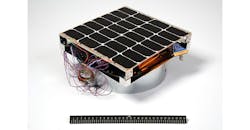Sunlight provides energy to many terrestrial applications by means of square or rectangular photovoltaic panels. If mounted a little closer to the sun, however, the technology may help to maintain long-term communications links on orbiting satellites. To explore the possibilities, engineers from the U.S. Naval Research Laboratory (NRL) recently launched the photovoltaic radio-frequency antenna module (PRAM) aboard an Air Force X-37B orbital test vehicle. The experiment will investigate the capabilities of the 12 × 12 in. square tile module (see the figure) to transform energy from its solar panel to RF/microwave signals that can be transmitted to earth for conversion to energy by terrestrial electronic devices and systems.
“To our knowledge, this experiment is the first test in orbit of hardware designed specifically for solar power satellites, which could play a revolutionary role in our energy future,” said Paul Jaffe, PRAM principal investigator. Chris Depuma, PRAM program manager, added: “PRAM converts sunlight for microwave power transmission. We could’ve also converted for optical power transmission. Converting to optical might make more sense for lunar applications because there’s no atmosphere on the moon. The disadvantage of optical is you could lose a lot of energy through clouds and atmosphere.”
Satellites have used solar power as a source of energy for some time, but not in this manner, with the conversion to RF/microwave signals for the purpose of moving energy from one location to another. This first experiment will track the efficiency of the module over time as well as the effects of changes in temperature on performance. This early data will help optimize future versions of the energy-collecting PRAM unit. The NRL PRAM development team hopes to develop a fully functional solar-energy-collecting system that can be built into a dedicated spacecraft for transmitting usable power from space back to earth, avoiding the filtering effects of earth’s atmosphere on the sunlight and achieving higher power capture efficiency than terrestrial solar panels. The NRL has many contributing partners on this project, with Boeing, Gulfview Research, Odin Engineering, SpaceQuest, and the Department of Defense Space Test Program to name a few.
About the Author
Jack Browne
Technical Contributor
Jack Browne, Technical Contributor, has worked in technical publishing for over 30 years. He managed the content and production of three technical journals while at the American Institute of Physics, including Medical Physics and the Journal of Vacuum Science & Technology. He has been a Publisher and Editor for Penton Media, started the firm’s Wireless Symposium & Exhibition trade show in 1993, and currently serves as Technical Contributor for that company's Microwaves & RF magazine. Browne, who holds a BS in Mathematics from City College of New York and BA degrees in English and Philosophy from Fordham University, is a member of the IEEE.
